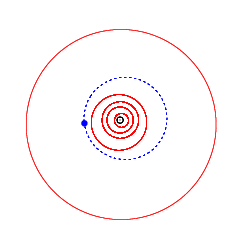9929 McConnell
|
| |||||||||||||
| Discovery | |||||||||||||
|---|---|---|---|---|---|---|---|---|---|---|---|---|---|
| Discovered by | Oak Ridge Observatory | ||||||||||||
| Discovery date | 24 February 1982 | ||||||||||||
| Designations | |||||||||||||
| MPC designation | (9929) McConnell | ||||||||||||
| 1982 DP1, 1984 WH3, 1996 GZ7 | |||||||||||||
| Orbital characteristics[1] | |||||||||||||
| Epoch 13 January 2016 (JD 2457400.5) | |||||||||||||
| Uncertainty parameter 0 | |||||||||||||
| Observation arc | 12426 days (34.02 yr) | ||||||||||||
| Aphelion | 2.5893789 AU (387.36557 Gm) | ||||||||||||
| Perihelion | 1.9630458 AU (293.66747 Gm) | ||||||||||||
| 2.2762123 AU (340.51651 Gm) | |||||||||||||
| Eccentricity | 0.1375823 | ||||||||||||
| 3.43 yr (1254.3 d) | |||||||||||||
| 353.55101° | |||||||||||||
| 0° 17m 13.207s / day | |||||||||||||
| Inclination | 6.008591° | ||||||||||||
| 43.743739° | |||||||||||||
| 62.170374° | |||||||||||||
| Earth MOID | 0.987939 AU (147.7936 Gm) | ||||||||||||
| Jupiter MOID | 2.55034 AU (381.525 Gm) | ||||||||||||
| Jupiter Tisserand parameter | 3.589 | ||||||||||||
| Physical characteristics | |||||||||||||
| Dimensions | ~12.9 km[2] | ||||||||||||
| ~0.01 | |||||||||||||
| |||||||||||||
| 14.4 | |||||||||||||
|
| |||||||||||||
(9929) McConnell) is a main belt asteroid. It orbits the Sun once every 3.43 years.[1]
Discovered on February 24, 1982 by the Oak Ridge Observatory, this asteroid was given the provisional designation "1982 DP1". It was later renamed "McConnell" after John C. McConnell, a historian of astronomy.[3]
John C. McConnell FRAS, (Fellow of The Royal Astronomical Society) who was born in May 1946, comes from Maghaberry, Northern Ireland, and is well known among both professional and amateur astronomers, takes a particular interest in observational astronomy and astrophotography, and also in the history of Irish astronomy, where he has amassed a vast collection of material. In 1999 he was awarded the Aidan P Fitzgerald Memorial Medal of the Irish Astronomical Association, and later made an Honorary Life Member of NIAAS.
The asteroid, (9929) McConnell, was discovered in 1982 at the Oak Ridge Observatory, in Harvard, Massachusetts, which was operated by the Harvard-Smithsonian Center for Astrophysics where Armagh Observatory's former Director Dr. Eric Mervyn Lindsay (1907-1974) spent a number of years working for his Ph.D. more than 70 years ago. The minor planet is very faint, being only 5 miles across and currently lying more than 130 million miles away from the Earth in the constellation of Canes Venatici. It has a nearly circular orbit passing close to the inner edge of the main asteroid belt between Mars and Jupiter.
References
- 1 2 "9929 McConnell (1982 DP1)". JPL Small-Body Database. NASA/Jet Propulsion Laboratory. Retrieved 13 April 2016.
- ↑ Tedesco E.F.; Noah P.V.; Noah M.; Price S.D. "The supplemental IRAS minor planet survey (SIMPS)".
- ↑ MPC 42670 Minor Planet Center
